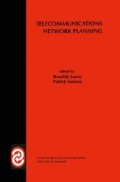Abstract
The continuous growth in traffic and the number of subscribers (4 million worldwide in 1988 vs 123 million in 1995, while about 400 million are expected in 2001), as well as the emergence of new technologies, are forcing telecommunication companies to optimize further the channel assignment of their cellular networks. A few years ago, the channel assignment problem wets formulated as an optimization problem with the objective of minimizing the order (i.e., the number of channels) or the channel span, subject to various interference constraints. Today, because of the rapid growth of cellular networks, all possible channels are used and it is usually impossible to assign channels with the guarantee that the networks (especially in urban areas) contain no interferences.
Access this chapter
Tax calculation will be finalised at checkout
Purchases are for personal use only
Preview
Unable to display preview. Download preview PDF.
References
CALMA project (Combinatorial ALgorithms for Military Applications), Europe. http://www.win.tue.nl/math/bs/combjopt/hurkens/calma.html.
Aardal, K.I., A. Hipolito, C.P.M. van Hoesel, B. Jansen, C. Roos and T. Terlaky. (1995). A Branch-and-Cut Algorithm for the Frequency Assignment Problem. Technical Annex T-2.2.1 A of the report of the EUCLID CALMA radio link frequency assignment project. ftp://ftp.win.tue.nl/pub/techreports/CALMA/T221A.ps/pub/techreports/CALMA/T221A.ps.
Adjakplé, P. (1998). Affectation de canaux dans les réseaux de téléphonie mobile cellulaire. PhD thesis, École Polytechnique de Montréal.
Adjakplé, P. and B. Jaumard. (1998). A New Class of Lower Bounds on the Quality of Channel Assignments using Column Generation Techniques. Working paper, GERAD, École des Hautes Études Commerciales, Montréal.
Borndörfer, R., A. Eisenblätter, M. Grötschel and A. Martin. (1998). Frequency Assignment in Cellular Phone Networks. Annals of Operations Research, 76:73–93.
Cplex. Using the Cplex Callable Library. Cplex Optimization Inc., 1995.
Desrosiers, J., Y. Dumas, M.M. Solomon and F. Soumis. (1996). Constrained Routing and Scheduling. In M.O. Ball, T.L, Magnanti and G.L. Nemhauser (eds), Network Models, Handbooks in Operations Research and Management Science, pages 35–139. Elsevier, North-Holland, Amsterdam
du Merle, O., P. Hansen, B. Jaumard and N. Mladenović. (1997). An Interior Point Algorithm for Minimum Sum of Squares Clustering. Les Cahiers du GERAD, G-97-53, École des Hautes Études Commerciales, Montréal.
Fischetti, M., C. Lepschy, G. Minerva, G.R. Jacur and E. Toto. (1997). Frequency Assignment in Mobile Radio Systems using Branch-and-Cut Techniques. Working paper, University of Padova, Italy.
Gamst, A. (1986). Some Lower Bounds for a Class of Frequency Assignment Problems. IEEE Transactions on Vehicular Technology, 35(1):8–14.
Gamst, A. and W. Rave. (1982). On Frequency Assignment in Mobile Automatic Telephone Systems. Proceedings of Globecom′82, pages B3.1.1-B3.1.7
Giortzis, A.I. and L.F. Turner. (1996). A Mathematical Programming Approach to the Channel Assignment Problem in Radio Networks. In Proceedings of IEEE 46 th Vehicular Technology Conference, 2:736–740.
Hansen, P., B. Jaumard and C. Meyer. (1998). An Exact Algorithm for Unconstrained Quadratic 0-1 Problems. Working paper, GERAD, École des Hautes Études Commerciales, Montréal.
Hurkens, C.A.J. and S.R. Tiourine. (1995). Upper and Lower Bounding Techniques for Frequency Assignment Problems. Working paper, University of Twente, The Netherlands. ftp://ftp.win.tue.nl/pub/techreports/cosor/95-34.ps/pub/techreports/cosor/95-34.ps.
Hurley, S., S.U. Thiel and D.H. Smith. A Comparison of Local Search Algorithms for Radio Link Frequency Assignment Problems. In ACM Symposium on Applied Computing, pages 251–257, Philadelphia, PA.
Janssen, J. and K. Kilakos. (1996). Polyhedral Analysis of Channel Assignment Problems: (I) Tours. Technical Report CDAM-96-17, London School of Economics and Political Science, London, UK.
Jaumard, B. (1997). Projet ECLIPSE: A Multiphase Heuristic for the Optimization of Channel Assignment in Bell Mobilité Cellular Systems. Working paper, GERAD, École des Hautes Études Commerciales, Montréal.
Jaumard, B., O. Marcotte and C. Meyer. (1998). Estimation of the Quality of Cellular Networks using Column Generation Techniques. Les Cahiers du GERAD, G-98-02, École des Hautes Études Commerciales, Montréal. http://www.crt.umontreal.ca/~nicolep/G9802.ps/~nicolep/G9802.ps.
Kazantzakis, M.G., P.P. Demestichas and M.E, Anagnostou. (1995). Optimum Frequency Reuse in Mobile Telephony Systems. International Journal of Communication Systems, 8:185–190.
Koster, A.M.C.A., S.P.M. van Hoesel and A.W.J. Kolen. (1997). The Partial Constraint Satisfaction Problem: Facets and Lifting Theorems. Research Memorandum rm97-005, University of Maastricht, The Netherlands. ftp://ftp.unimaas.nl/pub/greyJiles/fdew/1997/rm97-005.ps/pub/greyJiles/fdew/1997/rm97-005.ps.
Lee, W.C.Y. (1995). Mobile Cellular Telecommunications: Analog and Digital Systems. Second edition, McGraw-Hill, New York, NY.
Lochtie, G.D. and M.J. Mehler. (1995). Subspace Approach to Channel Assignment in Mobile Communication Networks. In IEE Proceedings on Communication, 142(3):179–185.
Mehrotra, A. and M.A. Trick. (1996). A Column Generation Approach for Graph Coloring. INFORMS Journal on Computing, 8(4):344–354.
Parenteau, P. (1992). Développement d’un algorithme exact pour la programmation non linéaire en variables 0-1 sans contraintes. Technical report, Institut National des Télécommunications, Évry, Prance. Undergraduate Project.
Smith, D.H. and S. Hurley. (1997). Bounds for the Frequency Assignment Problem. Discrete Mathematics, 167/168:571–582.
Tiourine, S., C. Hurkens and J.L. Lenstra. (1995). An Overview of Algorithmic Approaches to Frequency Assignment Problems, Working paper, University of Twente, The Netherlands, ftp://ftp.win.tue.nl/pub/techreports/CALMA/overview.ps/pub/techreports/CALMA/overview.ps.
Tcha, D.-W., Y.-J. Chung and T.-J. Choi. (1997). A New Lower Bound for the Frequency Assignment Problem. IEEE/ACM Transactions on Networking, 5(1):34–39.
Thienel, S. (1997). ABACUS 2.0. User’s Guide and Reference Manual. Technical report, Universität zu Köln, Germany. http://www.informatik.uni-koeln.de/ls juenger/projects/abacus/manual.ps.gz http://www.informatik.uni-koeln.de/ls juenger/projects/abacus/manual.ps.gz.
Warners, J.P., T. Terlaky, C. Roos and B. Jansen. (1997). A Potential Reduction Approach to the Frequency Assignment Problem. Discrete Applied Mathematics, 78:251–282.
Editor information
Editors and Affiliations
Rights and permissions
Copyright information
© 1999 Springer Science+Business Media New York
About this chapter
Cite this chapter
Jaumard, B., Marcotte, O., Meyer, C. (1999). Mathematical Models and Exact Methods For Channel Assignment in Cellular Networks. In: Sansò, B., Soriano, P. (eds) Telecommunications Network Planning. Centre for Research on Transportation. Springer, Boston, MA. https://doi.org/10.1007/978-1-4615-5087-7_13
Download citation
DOI: https://doi.org/10.1007/978-1-4615-5087-7_13
Publisher Name: Springer, Boston, MA
Print ISBN: 978-1-4613-7314-8
Online ISBN: 978-1-4615-5087-7
eBook Packages: Springer Book Archive

